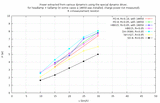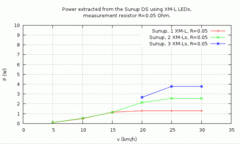
| [ Main index » Bicycle components tests » (Dynamo) bicycle lighting analysis » Dynamos » Dynamo comparison | ] |
I wrote in 2012: "This section will be expanded gathering data from various places on my website and adding stuff I didn't write down yet etc."
2016-3-17: So, for a long time no updates on this page, too much else on my mind and other things to do. But soon I will do a measurement of a Acxing Go go shine dynamo and Renak experimental hub, using the StVZO standard method to measure, using a resistor and a Fluke 289 multimeter.
I did such power output tests for a PD-8 and DH-3N80 already a few years ago using an Agilent (now Keysight) U1273A True-RMS meter, confirming that these provide 3.0W at 15 km/h. But it is more interesting to see what the experimental Renak hub and the Acxing will do.
A few notes about multimeters: I like the U1273A with OLED display, although that display doesn't work at all outside in daylight (even just overcast). I used an old Kaise SK-6220 which I liked better than the Voltcraft VC-230 but both are far inferior to the cheap AN8009, and of course to the U1273A and the Fluke 289 that I now use. It's the most accurate of any heldheld multimeters, but it's so big and heavy that I'd like something smaller sometimes, and for that purpose I bought the AN8009. It's even smaller than the 1980s Kaise SK-6220, which is quite small comapred to newer multimeters (154 mm x 83 mm x 37 mm height incl. knob) and light weight (200 g + 2 AA), fairly quick in measuring too, much nicer in use than the bigger VC-230 which I never liked (e.g. the capacitance measurement is rubbish, and the leads are far too stiff), but I had to retire the Kaise due to e.g. corroded battery compartment, hmm.... Both are of course way worse in features and accuracy than the Fluke 289, but also than the very cheap AN8009. Comparing it to the Fluke 289 gives near identical results on voltage measurements, capacitance is a different matter, there it deviates up to 2% from the Fluke. Temperature measurement is quite close, all in all an excellent low cost meter to have besides a expensive one (as having 2 meters is much better than 1 for various tasks!).
Note that top end stuff is not really needed, it's more a luxury (and accesories for expensive equipment are also expensive and often not better quality, see for example Fluke's ridiculously overpriced multimeter storage bags! And yes, those are made in China, just sold for 4 times the price of any other bags). Most cheap multimeters are in fact quite accurate, much better than the 1980s Kaise and will do very well for most tasks around the house or in electronics.
Measurement setup:
- StVZO measurement resistor: 12 Ohm, simply measuring the voltage across that resistor is enough.
- For measuring systems with LEDs I use a current measurement resistor (say 0.1 Ohm or 0.05 Ohm) and measure the voltage across that (from which you can calculate the current), as putting a multimeter in series gave issues in a few cases. Possibly it was just the VC230 that was the problem...
- Fluke 289 multimeter.
From the voltage you can calculate power supplied to this resistive load (P=V^2/R, so V^2/12)
Results to come:
I tested the SP PD-8, SP SD-8, SP PD-7 (=HB015), Shimano DH-3N80, Sanyo NH-H27. Still to do: Shimano HB-NX70.
Using the special dynamo driver which powered 3 XM-Ls I measured the power supplied to the LEDs. The results show that the Sanyo NH-H27 indeed supplies less power than the other dynamos. Further it turned out the power supplied by the SD-8 (dynamo meant for small wheels) in a 622mm wheel is a lot lower, in line what I had expected at first considering the specified wheel size; a true 2.4W dynamo should provide a bit more power. A test as done according to StVZO/TA with a resistor of 12 Ω is yet to be done.
2011-12-10: Here are the results in a graph:

The experimental dynamo driver is optimized for Shimano dynamo hubs, so perhaps with some tweaking power output can be improved with the others (Power output for the DH-3N80 is highest of the dynamos I've tested so far).
Note that the current through the LEDs is limited to ca. 0.85A in the driver (as it was originally meant for the LBL; the Rebel LEDs are rated to 1.00A maximum) and when using the Shimano DH-3N80 you get to this current at below a speed of 30 km/h, which causes the curve to go down. So it's possible to get more power from that dynamo at 30km/h.
The measurements of the PD-7/HB015 are not linear while all other dynamos's have a nearly linear relationship of power/speed. This could be the result of a few problems I had at one point with measurements due to connectors not making good contact from vibrations. I need to check that by redoing the measurement.
More data here.
The Sunup cannot be tested in the same way using that dynamo driver, as that is specifically meant for alternating current source. I have tested the power output of the Sunup in a different manner: A single XM-L, or 2 or 3 in series attached directly to the Sunup generator and measured the current through the LEDs and the voltage over the LEDs.
2011-12-10: Here are the results in a graph:

Detailed results in table form are on the Sunup review page.
| To email me go to the email page |
Last modified: 2018-2-21